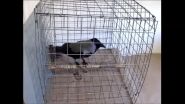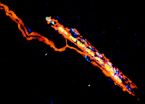(Press-News.org) The part of the brain that tells us the direction to travel when we navigate has been identified by UCL scientists, and the strength of its signal predicts how well people can navigate.
It has long been known that some people are better at navigating than others, but until now it has been unclear why. The latest study, funded by the Wellcome Trust and published in Current Biology, shows that the strength and reliability of 'homing signals' in the human brain vary among people and can predict navigational ability.
In order to successfully navigate to a destination, you need to know which direction you are currently facing and which direction to travel in. For example, 'I am facing north and want to head east'. It is already known that mammals have brain cells that signal the direction that they are currently facing, a discovery that formed part of the 2014 Nobel Prize in Physiology or Medicine to UCL Professor John O'Keefe.
The latest research reveals that the part of the brain that signals which direction you are facing, called the entorhinal region, is also used to signal the direction in which you need to travel to reach your destination. This part of the brain tells you not only which direction you are currently facing, but also which direction you should be facing in the future. In other words, the researchers have found where our 'sense of direction' comes from in the brain and worked out a way to measure it using functional magnetic resonance imaging (fMRI).
"This type of 'homing signal' has been thought to exist for many years, but until now it has remained purely speculation," explains Dr Hugo Spiers (UCL Experimental Psychology), who led the study. "Studies on London cab drivers have shown that the first thing they do when they work out a route is calculate which direction they need to head in. We now know that the entorhinal cortex is responsible for such calculations and the quality of signals from this region seem to determine how good someone's navigational skills will be."
In the study, 16 healthy volunteers were asked to navigate a simple square environment simulated on a computer. Each wall had a picture of a different landscape, and each corner contained a different object. Participants were placed in a corner of the environment, facing a certain direction and asked how to navigate to an object in another corner.
"In this simple test, we were looking to see which areas of the brain were active when participants were considering different directions," says Dr Spiers. "We were surprised to see that the strength and consistency of brain signals from the entorhinal region noticeably influenced people's performance in such a basic task. We now need to investigate the effect in more complex navigational tasks, but I would expect the differences in entorhinal activity to have a larger impact on more complex tasks.
Dr Martin Chadwick (UCL Experimental Psychology), lead author of the study, said: "Our results provide evidence to support the idea that your internal 'compass' readjusts as you move through the environment. For example, if you turn left then your entorhinal region should process this to shift your facing direction and goal direction accordingly. If you get lost after taking too many turns, this may be because your brain could not keep up and failed to adjust your facing and goal directions."
The entorhinal region is one of the first parts of the brain affected by Alzheimer's disease, so the findings may also help to explain why people start to get lost in the early stages of the disease. The researchers hope to develop their simple simulation task so that it might be used to aid early diagnosis and monitor the progression of the disease.
Dr John Isaac, Head of Neuroscience and Mental Health at the Wellcome Trust said: "Neuroscientists have made huge advances in our understanding of how we navigate space, widely recognised after this year's Nobel Prizes, and this research is yet another step forward. Why some people are better navigators than others is intrinsically interesting, but it also helps us explain the processes that go wrong in people with degenerative brain disorders such as dementia. An estimated 850,000 people are living with dementia in the UK, many of whom suffer deterioration in their navigational skills, leaving them lost and confused."
INFORMATION:
VIDEO:
Research from Univ. of Iowa and Russian scientists show crows are capable of executive-level thinking.
Click here for more information.
Crows have long been heralded for their high intelligence - they can remember faces, use tools and communicate in sophisticated ways.
But a newly published study finds crows also have the brain power to solve higher-order, relational-matching tasks, and they can do so spontaneously. That means crows join humans, apes and monkeys in exhibiting ...
TORONTO -- Very small segments of genes called "microexons" influence how proteins interact with each other in the nervous system, scientists at the University of Toronto have found, opening up a new line of research into the cause of autism.
The researchers found that microexons are used in neurons by alternative splicing, a process in which a single gene can produce many different proteins. Microexons are pasted -- or spliced -- into gene messengers (mRNAs) to generate forms of proteins that the nervous system needs to function properly. Misregulation of this process, ...
RESEARCHERS have discovered the unique genetic paths that the childhood brain tumour medulloblastoma follows when the disease comes back, according to research* published in Cancer Cell today (Thursday).
The study - funded by Cancer Research UK, Action Medical Research and others** - shows that taking an extra tumour sample at recurrence, when there are no effective therapies, could identify subsets of patients that might be treatable with existing drugs that target the genetic faults.
The scientists, based at Newcastle University and The Institute of Cancer Research ...
There are two main families of bacteria : those that are surrounded by a single membrane (or one outer wall) and those that are surrounded by two membranes (or two outer walls). The team of Jean-François Collet, professor at the de Duve Institute at UCL, looked at this second type of bacteria.
For a bacterium to survive, it has to keep its two outer walls intact. If one of these walls is damaged, the bacterium dies. So it was vital for the UCL researchers to analyse the protection mechanisms of these bacterial "walls' (to find their weak spot), so as to be able to ...
This latest research by Joshua Brickman and his research team from Danish Stem Cell Center (Danstem) at the University of Copenhagen specifically found that inhibiting or blocking stem cells ability to make a specific decision, leads to better cell growth and could lead to defined ways to differentiate stem cells.
This research is the first comprehensive analysis of a pathway important for stem and cancer cell decisions known as Erk. As a result this work could contain clues to cancer treatment as well as helping to establish a platform to make stem cell treatments for ...
After an incomplete spinal cord injury, the body can partially recover basic motor function. So-called muscle spindles and associated sensory circuits back to the spinal cord promote the establishment of novel neuronal connections after injury. This circuit-level mechanism behind the process of motor recovery was elucidated by Prof. Silvia Arber's research group at the Biozentrum, University of Basel and the Friedrich Miescher Institute for Biomedical Research. Their findings may contribute to designing novel strategies for treatment after spinal cord injuries and have ...
Walter and Eliza Hall Institute researchers have for the first time revealed how dying cells are hidden from the immune 'police' that patrol the body.
The research answers a decades-old mystery about the death of cells, which in some situations can alert the immune system to potential danger, but in other circumstances occurs 'silently', unnoticed by immune cells.
Silent cell death, or apoptosis, is a controlled way for the body to eliminate cells that may be damaged, old, or surplus to the body's requirements, without causing collateral damage. This 'normal' cell death ...
This news release is available in Spanish. The genome is the cell's book of instructions. All the cells in our body contain the same genomic information but each of them "reads" the gene fragments that interest them in order to carry out their function. So, neurones, hepatocytes and cardiac cells are different although their genome is the same. In order to achieve this huge variety of functions from the same genome, the cells employ a mechanism known as alternative splicing. This enables them to combine several fragments - known as exons - from the same genes in order ...
Mountain View, Calif. - December 18, 2014 - 23andMe, Inc., the leading personal genetics company, today announced the publication of a study that pinpoints fine-scale differences in genetic ancestry of individuals from across the United States.
Since immigrants first arrived more than four hundred years ago, the United States has served as a meeting place for peoples from different continents. This study illuminates how American history and the ongoing mixing of peoples with African, European, and American origins can be seen in our DNA.
"The relationship between genomics ...
HOUSTON - (Dec. 18, 2014) - Cars that run on natural gas are touted as efficient and environmentally friendly, but getting enough gas onboard to make them practical is a hurdle. A new study led by researchers at Rice University promises to help.
Rather than shoehorn bulky high-pressure tanks like those used in buses and trucks into light vehicles, the Department of Energy (DOE) encourages scientists to look at new materials that can store compressed natural gas (CNG) at low pressure and at room temperature. Cage-like synthetic macromolecules called metal organic frameworks ...



